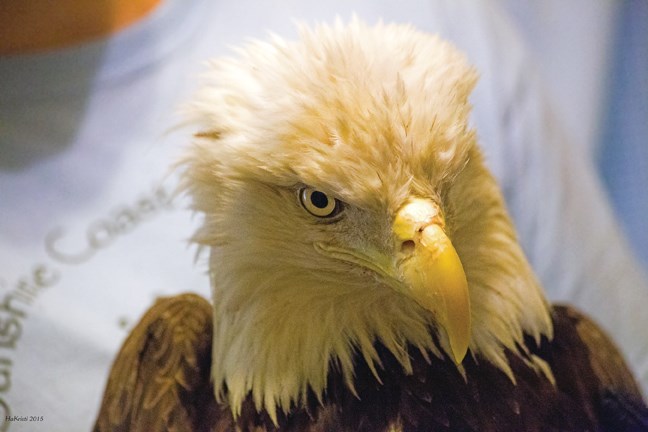An emaciated bald eagle that could no longer fly and was living in the woods beside the dump was rescued by the Gibsons Wildlife Rehabilitation Centre (GWRC) on Aug. 30.
The centre was called about the sick eagle by staff at the Sechelt Landfill, who reported that it was the only eagle left at the landfill. The other eagles had flown away to feast on fish spawning in local creeks and rivers.
Another man called about the bird soon after, saying he could pinpoint where the eagle was. He offered to stay onsite until rescuers could arrive so he could lead them to it.
“It couldn’t fly. I guess it was so weak that it couldn’t take off so when the fellow went towards it, it just walked away into the bush,” said Irene Davy of the GWRC.
Once on site, Clint Davy said he found the eagle propped up on a log, which was “festooned and covered in plastic bags and rubbish.”
The eagle was covered in external parasites, which Clint said is common in birds that have been living on the forest floor for some time.
After the bald eagle was captured with a net, Clint and Irene realized it had a leg band attached to it, indicating that the same bird had been treated by the Orphaned Wildlife Centre (OWC) in Delta at some point.
The couple called the centre and discovered the eagle had been found starving in North Vancouver in November 2007. The eagle was nursed back to health at that time and released in Squamish in March 2008.
In 2007, the OWC suspected the eagle was four years old, which makes him about 12 years old now, Clint said.
As to why he’s been found starving and in need of assistance again, Clint was unsure.
“Who knows? It may not be a particularly good hunter or forager or it may have some ongoing physical problem that nobody’s been able to pinpoint. But the fact that it’s survived from 2008 till now, obviously whatever was wrong with it is nothing really serious,” Clint said.
The GWRC is not equipped to care for large birds of prey long term, but it has been caring for the eagle since the end of August, slowly reintroducing it to fluids and then food.
“Because it was starving we couldn’t give it food right away because that would kill it. It takes too much energy to process it, so we have to tube them with rehydrating fluids first,” Clint said.
The eagle is slowly getting better but it’s still not well enough to fly, via helicopter, to the OWC for further treatment. The OWC specializes in caring for large birds of prey.
“We will send him over to Orphaned Wildlife as soon as we can get it arranged and we feel that he is strong enough to handle the trip,” Clint said.
Bald eagles can live up to 30 years and the Davys are hopeful the eagle in their care will have a long life ahead of him, once he’s nursed back to health.
The GWRC is a non-profit centre funded by donations and is always looking for more volunteers to help with its mission of assisting injured and orphaned wildlife on the Coast. Find out more on their website at www.gibsonswildliferehabcentre.org



